 The Glass Castle is a memoir of Jeanette Walls childhood with her three brothers and sisters, which was not exactly all rainbows an unicorns. Her parents are both unstable and dysfunctional. Initially the family lives in the southwest, living from day to day, and moving from town to town. When things get desperate, they end up moving in with family in a small, miserable mining town in West Virginia at which point things go from bad to worse. Just describing the outlines of Walls childhood makes me depressed. It sounds like the kind of memoir that is cathartic for the author to write, but feels voyeuristic to actually read. However, this book came highly recommended from a friend so I persevered, and I am glad I did. Walls's strength and her and her siblings ability to transcend the circumstances they were born into is nothing short of inspiring. However, the thing that made her story special is not that she survived despite the fact that her parents were dysfunctional. Instead, despite everything they put her through, she still loved them, and had learned something from them about choosing a lifestyle rather than accepting what society dictates. Long Story Short: Bring your tissue box, expect to be outraged, but it is a surprisingly engaging and uplifting read.
Brain, meet Big Data. The Human Connectodome Project is an effort by a multidisciplinary group of scientists, engineers, and computer scientists to understand the wiring stored in the human skull. The initial effort is to scan the brains of 1200 people with an MRI to collect detailed data on brain patterns. The MRI data will be combined with genetic information and behavioral information to understand the interaction between the human brain and human behavior with a data density that would have been hard to fathom even a decade ago. Aside from making really pretty pictures, why does it really matter to know the routes that info travels around in our brains? In the words of the director of the NIH: "With a detailed connectome map of a normal human brain, I believe we will gain a better understanding of the roots of human neurological disorders, including schizophrenia, autism spectrum disorders, and other baffling conditions that may arise from abnormal “wiring” during brain development. This knowledge should yield new and better ways to detect, treat, and, ultimately, prevent the brain disorders that currently disrupt and devastate so many lives.
The connectome will also give us a new tool to explore how genes influence the brain’s connections—and how behavioral and environmental factors act to sculpt those connections, affecting everything from our ability to solve crossword puzzles to our risk for addiction.Image Credits: Human Connectodome Project
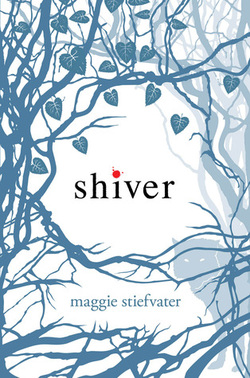 To preface this entry, I should share something about myself. We read Romeo and Juliet in my 8th grade literature class. I didn't like it. Partly because I am firmly committed to reading prose. But. Even when my hormones were the fiercest and my emotions turned on a knife edge, I did not believe in love at first site. Let alone love at first staring deeply into the eyes of a werewolf while being dragged of into the wilderness from your swingset. So when I say, Shiver is young adult literature that reads like young adult literature, keep in mind that I didn't even like young adult literature as a young adult. If you (or your local young adult) enjoyed Twilight, Shiver is probably up your ally. Disclaimers completed.
Shiver is the story of Grace who was attacked by wolves as a small child, but was saved by a beautiful yellow eyed wolf. She has loved the wolves ever since, and when she is a senior in high school discovers that the wolf is really an emo werewolf, Sam. Star crossed lover story ensues.
This book did not do it for me.
Reason #1 - I like my female protagonists strong. Grace is not completely without backbone, but there is really nothing interesting about her. She has no interests, passions, or opinions other than the fact that the wolves that tried to eat her as a small child are really great. Reason #2 - There is no overarching plot or challenge for the characters to work through. There are some subplots - will Sam turn into a werewolf forever? Will Grace be able to maintain her human friendships now that she is in love with a werewolf? Will Sam be able to write the perfect song lyrics to make Grace understand how he feels about her (barf)? If I'm going to spend time with a novel that is purely about spending time with the characters, they had better be better company than Grace and Sam. Reason #3 - Absentee parent syndrome. I understand that to write a book about kids where the kids get to do things that normal kids can't, there has to be a reason that the adults aren't paying attention. Hence why the parents in every Roald Dahl children's book are either dead or twisted. But this is about a 17 year old girl. Parents that would notice that a boy has moved into their 17 year old daughter's bedroom would actually make this story more interesting, not less. Long Story Short - If you're into love at first site stories and emo werewolves, you will probably like this. If not, the fantasy of this fantasy world is not engaging enough to be worth your time.
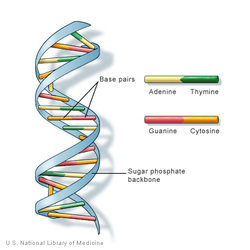 If you remember your high school biology, you know that DNA has a "double helix" structure. It made up of pairs of proteins (Adenine/Thymine and Guanine/Cytosine) with a sugar molecule on one side and a phosphate molecule on the other. When you stack them on top of each other, it forms the spiraling "helix" structure we think of for DNA. All of this is old news. It was discovered by Watson and Crick ( well, really Rosalind Franklin) back in the 50's.
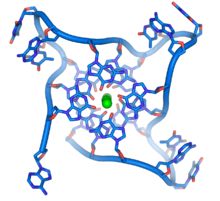 What is new to me, is that DNA can also form into a quadruple helix. In this case, four molecules of a single nucleic acid (ie Guanine) bond together to make a flat plate structure. When these plates stack on top of each other you get a "G-quadraplex" aka quadruple helix DNA. However, historically, this was just a fun lab trick. There was no evidence that such a structure actually formed in nature in any stable way.
But a recent report in Nature Chemistry, shows evidence that the G-quadraplexes are present in cancer cells. New Scientist interviewed one of the researchers who explained that the G-quadraplexes are typically temporary structures present during the division of cells and are present in a structure called the telemere, the cap of a chromosome. Since cancer cells typically replicate very quickly, telemeres are frequently not replicated accurately. What is really exciting is that the compound the team used to stabalize the G-quadraplexes in cancer cells and prevent them from naturally reverting to a double helix (pyridostatin) has been previously shown to prevent replication of breast cancer cells. This result suggests that pyridostatin could potentially be used to treat cancer and that further understanding of the transitory nature of DNA structures is an important thing to understand. Score one for playing around in the lab. Off to light things on fire and see what color they burn. Image Credits: NIH, Wikipedia
In my recent entry of cool science fiction technologies that people made in real life, Interesting Engineering indicated that teleportation is no a reality. Say What? If Scotty can now beam me around places, I do not know what I was doing waiting for a 9 hour layover in Heathrow recently. Before you get too excited about your new 40 millisecond commute, we cannot yet teleport people. However, we (humanity) have teleported photons from one Canary Island to another! That is so amazing and exciting! Wooo! Wait. I have no idea what that really means. | | Enter Wikipedia. What is quantum teleportation, really? Quantum teleportation is transferring a single piece of quantum information from one place to another without that information traveling through the intervening space. It is not the same as Star Trek type teleportation where an entire system (ie you) is copied and moved from one place to another. Sadly, there is a quantum proof saying that such things are not possible. What is possible is making a computer that makes this laptop look about as useful as a stack of punch cards aka quantum computing. For reasons that are about as clear to me as how this computer works in the first place, the ability to transfer information from particle phase into photons and teleport them. And we can do that now!
So, I'm disappointed that I won't be teleporting home next weekend, Image credits: Geek Magazine
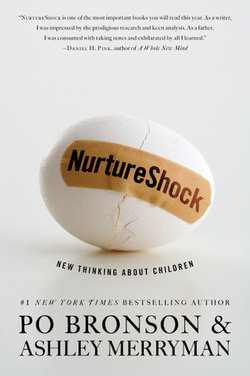 When I was in college, I started reading Carolyn's Hax's advice column in the Washington Post. I have read it fairly religiously ever since, so Hax's voice has been in my mind from my first date through my marriage. and has certainly been handy along the way. From time to time, she recommends a book, and Nurture Shock by Po Bronson and Ashley Merryman is one of the most highly recommended books from the site. Nurture Shock is a compilation of research into child development and is touted to revolutionize the way we think of kids brains and explain why so many well meaning parenting techniques fail. So there are two reasons you should not trust my review of this book. #1 - as a devoted advice column reader, I know that people without kids (aka me) should never ever give parenting advice. I read this book because I think brains are interesting, not because I have a live experiment to test it out on. #2 - the book itself refers to outdated science based books about child development with a certain degree of scorn and total lack of self awareness that the science in this book will likely eventually be debunked or at least refined. That said, I found it really interesting and 40% of the "pages" in my kindle version are references to scientific studies, so they certainly did their homework. Here are some tidbits to whet your appetite. - Praising kids for being smart actually backfires and makes them perfectionists afraid to fail. Praising kids for working hard makes them work harder and actually be smarter.
- There is a period of sleep state where people translate their daily experiences into memory/knowledge. For adults, it lasts something like 3 minutes an hour. For kids, its more like 40 minutes. So sleep deprivation for kids has a huge effect on lots of different things. One particularly interesting study was on the effect of SAT scores on a high school when the start time of the school was changed to an hour later in the day. Huge.
- Not specifically talking about race with a child in a multicultural environment, does not prevent the child from including skin color in their categorizations of the world. It actually makes them more likely to choose friends of the same skin color as kids pick the people most like them. But if you wait until the child is old enough to ask about it himself, it is too late to drastically alter their behaviors (in terms of grade school friend choice).
- All kids lie. In fact, successful lying is a sign of intelligence. But by the time a child is a teenager, they are likely to be pretty good at it. At that point, arguing a lot with parents is actually a sign of respect.Even among "good kids" (high achievers) the more kids argued and negotiated with their parents, the more they respected them. The kids who didn't respect their parents just lied. But the parents of the arguers thought they had a bad relationship with their kids, and the parents of the liars though their relationship was great!
Long Story Short: Fascinating book, well written, well worth the read if you ever plan on knowing a child.
I am very interesting in street photography at the moment, inspired by things like Humans of New York and Orchard Road. I want to do a collection of my own photos of strangers here in Brno. It is really a triple project for me as I will have to improve my ability to talk to stranger dangers, speak in Czech, and take portrait photos. I will post them as a collection to a separate page here for my Faces Project, but here is my favorite photo from my first attempt.
Interesting Engineering has a list of their top 10 sci-fi and fantasy technologies that someone actually invented. - Silk stronger than steel
- Stealth mantle aka invisibility cloak
- Sprayable skin
- Life extending cells
- 3D house building printer
- Self driven cars
- Mind guided hand
- Humanoid robot capable of doing obstacle courses
- Space vessel reaching the edge of our solar system (Go Voyager Go!)
- Teleportation (Wait.. seriously? I will research this and post more in the future)
So all of that is pretty cool and I'm certainly glad to know that it is not unrealistic for Harry Potter to be sneaking around Hogwarts and night with his invisibility cloak. That said, I think scientists/engineers (please, google?) should be working on the following: What do you want to see? Image credits: All Around Skate, Deposit Photos, Subspace Communique, Life's Little Mysteries, eBorg2, FanPop
|

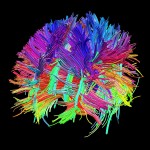











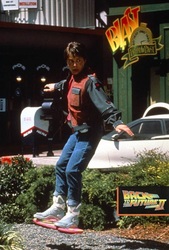




 RSS Feed
RSS Feed